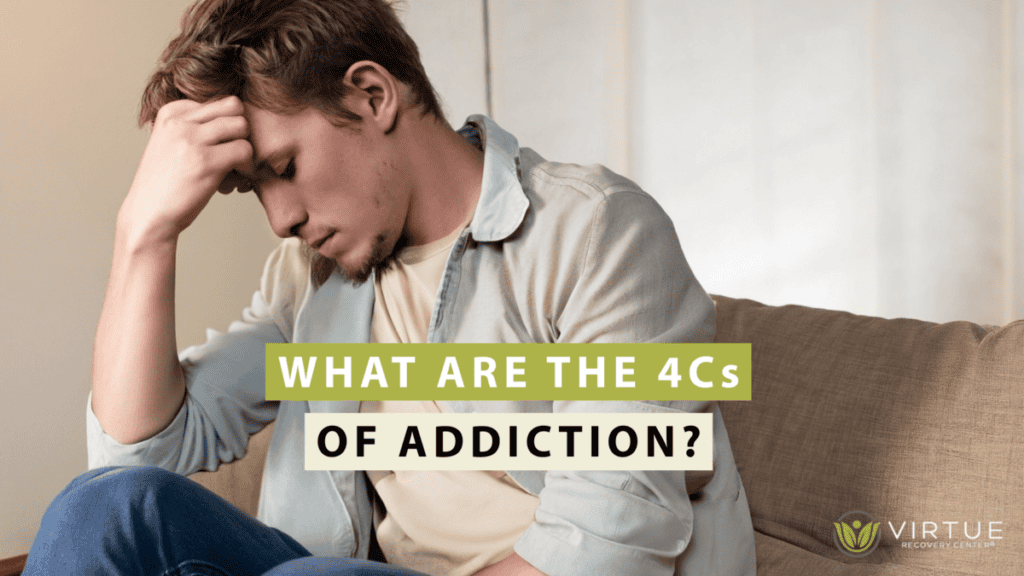Addiction is a complex disease that affects millions of people all over the world every year. At Virtue Recovery Killeen, we approach addiction as a complex disorder, and therefore, we use an individualized approach, creating treatment plans that meet the particular needs of each patient. This article will focus on the 4Cs of alcohol and drug addiction, a model that describes the different dimensions of addiction and serves as the basis for successful treatment.
The 4Cs of Addiction
The 4Cs of addiction—compulsion, craving, consequences, and control—offer a structured way to understand the mechanisms and impact of addiction on an individual’s life. Let’s break down each component:
- Compulsion: Begins with a compulsion or irresistible urge to engage in a particular behavior, such as using drugs or alcohol. This urge is so strong that it can override the rational part of the brain, pushing the individual towards substance use despite knowing the potential negative outcomes.
- Craving: Cravings are a strong desire to get and use drugs or alcohol that occur as a response to external cues (like seeing a bar) or internal states (such as stress). These cravings are powerful and can dominate a person’s thoughts, making it difficult to focus on anything other than obtaining and using illicit substances.
- Consequences: The consequences of addiction can be severe and life-changing, affecting health, relationships, physical well-being, social relationships, and financial stability. Despite experiencing negative outcomes, individuals with addiction may continue to use, which is a trademark of the disease.
- Control: Loss of control is a classifying aspect of addiction. This is about how much one consumes and the inability to stop using once started. It often leads to a cycle where the more one tries to regain control, the more chaotic the situation becomes.
Key Takeaways
| Term | Description |
| Compulsion | The irresistible urge to engage in substance use. |
| Craving | Intense desire triggered by internal or external cues. |
| Consequences | Negative impacts on health, relationships, and finances. |
| Control | The inability to stop using substances once started. |
In-depth Analysis of Compulsion and Craving in Addiction
Compulsion in Addiction
Compulsion is often the starting point in the addictive cycle. It involves an overwhelming urge to use substances due to changes in brain chemistry. Addiction alters the brain’s reward system, leading to an increased release of dopamine during drug use, which reinforces the behavior. Over time, the brain begins to associate drug use with pleasure or relief from pain, embedding these connections deeply within its circuitry.
Compulsion is the starting point in the addictive cycle. Addiction represents an uncontrollable desire to take drugs because of how the brain has been altered. Addiction changes the reward system of the brain by releasing more dopamine during drug use, which strengthens the behavior. Gradually, the brain starts to link drug use with pleasure or relief of pain; thus, these connections become deeply rooted in its circuitry.
Biological Basis of Compulsion
- Neurological Changes: Repeated substance use changes the way brain neurons communicate. These changes make the brain highly sensitive to the substance, leading to increased compulsion.
- Genetic Factors: Genetics can predispose individuals to higher levels of compulsion, making some more susceptible to addiction than others.
Craving in Addiction
Craving follows compulsion and can be triggered by both internal and external factors. It’s a powerful, often irresistible desire for the effects of the substance.

Triggers of Craving
- External Cues: Places, people, sights, and sounds associated with drug use can trigger intense cravings.
- Internal States: Emotional states such as stress, anxiety, or depression can also trigger cravings. This is why emotional regulation is a key focus in addiction treatment.
Managing Cravings
- Cognitive Behavioral Therapy (CBT) helps individuals recognize cues and patterns that lead to cravings and teaches strategies for managing them.
- Medication-Assisted Treatment (MAT): Certain medications can reduce cravings and normalize brain functions in individuals with substance use disorders.
The Interplay Between Compulsion and Craving
Understanding the interplay between compulsion and craving is crucial for effective treatment. Compulsion pushes an individual towards substance use, while craving keeps them locked in a cycle of addiction. Breaking this cycle requires a comprehensive approach that addresses both psychological and physiological aspects of addiction.
Strategies for Breaking the Cycle
- Detoxification: Safely removing the substance from the body under medical supervision.
- Relapse Prevention Education: Teaches individuals how to identify and manage triggers that lead to compulsion and craving.
- Supportive Therapies: Group therapy, peer support groups, and family therapy enhance recovery by providing social support and encouragement.
Understanding Environmental Cues and Stress Management
Environmental cues involve a broad set of external stimuli, which are linked to previous drug use experiences. Such cues may be as direct as going to a place where one used to use drugs, or they may be less explicit, like facing stressors that have been historically associated with drug use. When a person in recovery is exposed to such cues, it can trigger the memory of the pleasure associated with drug use, resulting in strong cravings.
Role of Environmental Cues in the 4Cs
- Compulsion: Environmental cues can intensify the compulsion to use drugs by stimulating memories of the positive effects associated with their use. For example, running into a group of friends with whom you used to drink or use drugs can immediately trigger the compulsion to engage in similar behaviors.
- Craving: Cravings are directly elicited by environmental cues. The brain, having been conditioned to associate certain places, people, or emotions with drug use, responds to these cues by generating cravings. This biological response is often automatic and can be overwhelming.
- Consequences: Continual exposure to environmental cues without effective coping mechanisms can lead to relapse, which carries significant negative consequences. These include detrimental impacts on health, relationships, and overall societal contributions, as the individual may revert to addictive behaviors.
- Control: Environmental cues challenge an individual’s control over their addiction. Recovery is about learning to manage responses to these triggers effectively. Gaining control over cravings triggered by environmental cues is crucial for long-term recovery and avoiding relapse.
Strategies to Manage Environmental Cues
Effective addiction treatment programs, like those offered at Virtue Recovery Killeen, incorporate strategies to help individuals recognize and cope with environmental cues:
- Awareness Training: Education about the nature of cues and their effects on the brain.
- Avoidance Strategies: Learning to avoid certain high-risk situations or triggers.
- Coping Skills Development: Using techniques like mindfulness, meditation, or stress management exercises to deal with cravings healthily.
- Behavioral Modification: Through therapies such as CBT, patients learn to change their responses to environmental cues, effectively rewiring how their brain reacts to such triggers.
FAQs About the 4Cs of Drug and Alcohol Addiction
Q: What are the 4Cs of addiction?
The 4Cs of addiction are Compulsion, Craving, Consequences, and Control. These components help in understanding the complex nature of addiction and the challenges faced during recovery.
Q: How does compulsion influence addiction?
Compulsion is the overwhelming urge to use substances despite knowing the negative outcomes. It is driven by changes in the brain’s reward system, reinforcing substance use.
Q: What triggers cravings in addiction?
Cravings can be triggered by both external and internal factors, including environmental cues like places and people associated with past use and emotional states such as stress or anxiety.
Q: Can environmental cues be managed to control addiction?
Yes, managing environmental cues is crucial in controlling addiction. Techniques include avoidance of triggers, awareness training, coping skills development, and behavioral modification through therapies like Cognitive Behavioral Therapy (CBT).
Q: What are the consequences of failing to manage addiction effectively?
Failing to manage addiction can lead to severe consequences affecting all aspects of an individual’s life, including health deterioration, strained relationships, financial problems, and overall life instability.
Q: What strategies are effective in breaking the cycle of addiction?
Effective strategies include detoxification, medication-assisted treatment, cognitive-behavioral therapy, relapse prevention education, and supportive therapies like group or family counseling.
Q: How does Virtue Recovery Killeen approach addiction treatment?
Virtue Recovery Killeen offers a comprehensive treatment program that addresses the biological, psychological, and social factors of addiction. This includes medical detox, individualized therapy, and support for managing environmental cues and triggers.
Q: Why is control important in the context of addiction?
Control is important because addiction often leads to a loss of control over substance use. Regaining control is essential for managing use, preventing relapse, and sustaining recovery.
Q: What role do genetics play in addiction?
Genetics can influence how susceptible an individual is to addiction by affecting how their brain responds to certain substances. Genetic factors may predispose individuals to more intense compulsions and cravings.
Q: How does Virtue Recovery Killeen help with craving management?
Virtue Recovery Killeen employs various therapeutic approaches, including medication, behavioral therapy, and support groups, to help individuals recognize and manage cravings effectively.
Sources:
PainScale – Describes the four Cs of addiction as unique factors that distinguish addiction from other neurological disorders, emphasizing their role in various types of addictions, including drugs, alcohol, and behavioral addictions.
Healthline – Offers a detailed article on the 4Cs of addiction, focusing on how these factors manifest in various types of addictions and their implications for treatment and recovery.
Verywell Mind – Discusses the 4Cs of addiction in the context of psychological and behavioral aspects, providing insights into how these factors affect the addiction cycle and recovery process.
Psychology Today – Features an article that explores the 4Cs of addiction, emphasizing the psychological underpinnings and the importance of recognizing these components for effective addiction treatment.
Medical News Today – Includes a comprehensive review of the 4Cs of addiction, detailing each component and discussing their role in both the development and treatment of addiction disorders.
- About the Author
- Latest Posts
Gigi Price holds licenses as a Master Social Worker and Clinical Drug Counselor. She completed her master’s degree in Social Work at Texas State University. Over the last decade, Gigi has been dedicated to utilizing evidence-based practices to enhance patient care and treatment planning, resulting in positive, long-term outcomes for patients and their families. Her passion lies in creating a treatment environment where professionals collaborate to bring about positive change and provide a safe, trustworthy therapeutic experience. Patients can be confident in receiving top-quality care under her leadership.
In her role as the Clinical Director of Virtue Recovery Houston, Gigi conducted research to identify the most effective approaches for treating patients with acute mental health diagnoses, PTSD, and Substance Use Disorder. She then assembled a team of skilled clinicians who could offer various therapeutic modalities, such as Cognitive Behavioral Therapy (CBT), Dialectical Behavioral Therapy
(DBT), Acceptance and Commitment Therapy (ACT), Somatic Exposure, Eye Movement Desensitization and Reprocessing (EMDR), and Cognitive Processing Therapy (CPT). Gigi takes pride in overseeing the development and implementation of Virtue Houston’s Treatment Program, which includes two specialized therapeutic curricula tailored to the unique needs of individuals struggling with mental health issues, addiction, and PTSD.









